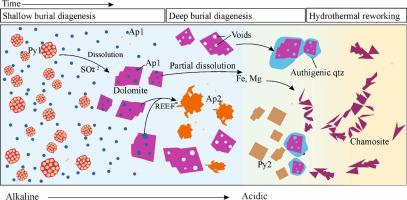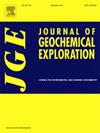印度磷矿的临界矿物潜力:库达帕盆地埃迪卡拉系沉积物中稀土元素富集的证据
IF 3.3
2区 地球科学
Q1 GEOCHEMISTRY & GEOPHYSICS
引用次数: 0
摘要
磷矿是一种潜在的非传统稀土元素来源,尽管其资源可行性仍在全球范围内进行评估。本研究首次记录了来自印度的富含稀土元素的沉积物磷矿,并评估了驱动稀土元素动员、富集和积累的过程。采用光学、扫描电镜、全岩地球化学、原位氟磷灰石(EPMA、LA-ICP-MS)和拉曼光谱分析等方法,对库达帕盆地库尔诺尔群奥克页岩组中与页岩和凝灰岩互层的伊迪亚卡拉系磷质层进行了分析。鉴定出两种磷灰石相:原生自生(Ap-1)、贫氟品种和次生/再沉淀富ree氟磷灰石(Ap-2)。全岩REE + Y浓度高达1075 ppm,具有典型的中等REE (MREE)富集模式,也记录在氟磷灰石中,这被解释为沉积物孔隙水成岩吸收的结果。REE + Y和氧化还原示踪剂Mn之间的强相关性表明,Mn-(氧)氢氧化物和有机物首先清除MREE,然后在Mn还原溶解过程中释放MREE。成岩作用增强了稀土元素的富集,成岩后的热液改造与火成岩侵入相结合,通过在互层页岩中形成丰富的绿泥石(辉钼矿)和稀土、磷的重新分布,稀释了稀土元素的富集。层序地层学分析表明,这些原始磷质岩是在海相退退过程中沉积的,没有经过改造,阻止了高品位磷质岩的形成,强调海平面变化在控制磷矿成因、形成磷质巨岩从而富集稀土元素方面的作用。全球磷质岩的时间分析进一步表明,在地球历史上,生物地球化学再循环和幕式风化作用调节的海水渐进式影响共同控制着磷质岩中稀土元素的富集模式。本文章由计算机程序翻译,如有差异,请以英文原文为准。

Critical mineral potential of Indian phosphorites: Evidence of REE enrichment in Ediacaran sediments from the Cuddapah Basin
Phosphorites constitute a potential non-traditional source of rare earth elements (REE), although their resource viability is still being evaluated globally. This study presents the first documentation of REE-enriched sediment-hosted phosphorites from India, and evaluates the processes driving REE mobilization, enrichment and accumulation. The Ediacaran phosphatic beds from the Owk Shale Formation, Kurnool Group of the Cuddapah basin, interbedded with shales and tuffs, were analysed using optical and SEM imaging, whole rock geochemical, in-situ fluorapatite (EPMA, LA-ICP-MS) and Raman spectroscopic analyses. Two apatite phases were identified: primary authigenic (Ap-1), fluorine-poor variety and secondary/reprecipitated REE-enriched fluorapatite (Ap-2). Whole-rock REE + Y concentrations reach up to 1075 ppm, with characteristic middle REE (MREE) enriched patterns, also recorded in fluorapatite, interpreted as a result of diagenetic uptake from sediment porewaters. A strong correlation between REE + Y and redox tracer, Mn indicates initial MREE scavenging by Mn-(oxy)hydroxides and organic matter, followed by MREE release during Mn-reductive dissolution. While diagenesis enhanced REE enrichment, post-diagenetic hydrothermal reworking associated with igneous intrusions diluted REE concentrations through the formation of abundant Fe![]() Mg chlorite (chamosite) and REE and P redistribution within the interbedded shales. Sequence stratigraphic analysis suggests that these pristine phosphorites were deposited during marine regression, without subsequent reworking, preventing the formation of high grade phosphorite deposit, emphasizing the role of sea-level changes in controlling phosphogenesis, formation of a phosphorite giant and thus, REE enrichment. A temporal analysis of global phosphorites further reveals that progressive seawater influence, modulated by biogeochemical recycling and episodic weathering, together controlled the REE enrichment patterns in phosphorites through Earth's history.
Mg chlorite (chamosite) and REE and P redistribution within the interbedded shales. Sequence stratigraphic analysis suggests that these pristine phosphorites were deposited during marine regression, without subsequent reworking, preventing the formation of high grade phosphorite deposit, emphasizing the role of sea-level changes in controlling phosphogenesis, formation of a phosphorite giant and thus, REE enrichment. A temporal analysis of global phosphorites further reveals that progressive seawater influence, modulated by biogeochemical recycling and episodic weathering, together controlled the REE enrichment patterns in phosphorites through Earth's history.
求助全文
通过发布文献求助,成功后即可免费获取论文全文。
去求助
来源期刊

Journal of Geochemical Exploration
地学-地球化学与地球物理
CiteScore
7.40
自引率
7.70%
发文量
148
审稿时长
8.1 months
期刊介绍:
Journal of Geochemical Exploration is mostly dedicated to publication of original studies in exploration and environmental geochemistry and related topics.
Contributions considered of prevalent interest for the journal include researches based on the application of innovative methods to:
define the genesis and the evolution of mineral deposits including transfer of elements in large-scale mineralized areas.
analyze complex systems at the boundaries between bio-geochemistry, metal transport and mineral accumulation.
evaluate effects of historical mining activities on the surface environment.
trace pollutant sources and define their fate and transport models in the near-surface and surface environments involving solid, fluid and aerial matrices.
assess and quantify natural and technogenic radioactivity in the environment.
determine geochemical anomalies and set baseline reference values using compositional data analysis, multivariate statistics and geo-spatial analysis.
assess the impacts of anthropogenic contamination on ecosystems and human health at local and regional scale to prioritize and classify risks through deterministic and stochastic approaches.
Papers dedicated to the presentation of newly developed methods in analytical geochemistry to be applied in the field or in laboratory are also within the topics of interest for the journal.
 求助内容:
求助内容: 应助结果提醒方式:
应助结果提醒方式:


